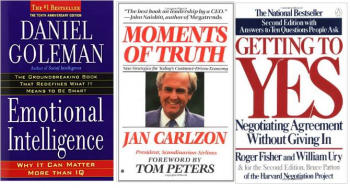
Dic 7, 2014 | The Blog
 Back in the Dark Ages, we used to rely on overhead projectors to deliver our presentations.
Back in the Dark Ages, we used to rely on overhead projectors to deliver our presentations.
These bulky, electromechanical devices were pretty quirky, as their halogen lamps had a tendency to burn out during presentations, thus causing instant mumbling among the spectators. What with the projector failing and the audience moaning, the speaker’s anxiety levels would redline as things got from bad to worse.
In the large multinational company I used to work for, this up-and-coming executive had just launched into the final part of his upbeat pitch when the projector’s bulb popped dead. His boss became visibly embarrassed and asked him if he carried a spare bulb; to which the young executive shook his head no—the unspoken question “why should I” clearly painted on his face.
To compound the tragedy, no spare lamp could be located in the building and the presentation fizzled out.
Company lore had it that the up-and-coming executive’s career soon followed suit.
No, it wasn’t me. But it could have been.
Since then, I made sure I always had a spare bulb in my pocket when I approached that treacherous machine with my sheaf of transparencies. (This was before the dual-lamp projectors were introduced, an authentic quantum leap in Jurassic technology).
A few decades have gone by and we have gotten spoiled with sophisticated HD multimedia projectors, amazing presentation software such as PowerPoint, Keynote and, lately, Prezi.
Still, it pays to adopt a “belt-and-suspenders” approach. I always carry my own HD projector in the car trunk when I drive to a training venue (too bad I can’t when I fly or ride a subway there). This proved a very good idea one day, when the company that hosted my slide presentation had an impressive array of three ceiling-mounted projectors—none of which, however, would recognize my laptop.
My slide deck is always on my notebook’s desktop and on a thumb-drive, and if a total blackout occurs I can still talk my way out of a total disaster with the help of a flip-chart or whiteboard. And I always carry a set of USB-powered mini-speakers for my laptop. In my experience, the audio equipment one finds in conference venues can be sketchy, while my mini-speakers will work just fine with audiences up to 20 people.
Don’t let a technological breakdown sap your spirit and confidence. Always have a backup plan.
Steve Jobs used to collect and rehearse little anecdotes from Apple’s early days so he could entertain his audience while his backstage crew rushed to fix some technical glitch during one of his signature presentations. And he arguably had the best technology in the world at his disposal.

Nov 14, 2014 | The Blog

As a consultant and trainer, I go through books like a snowplow. Having amassed more than three decades of experience on the sharp end of business, I cherish those books that help me make sense of it and convey it to my clients and seminar participants.
There are three old books that take pride of place on my bookshelf.
Emotional Intelligence by Daniel Goleman
This book contains Goleman’s ground-breaking insights into the tensions between reason and emotion, and the role that Emotional Intelligence (not IQ) plays in interpersonal relationships. Leaders who are long on IQ but short on EQ have their work cut out for them. Ever come across such types?
Getting to Yes by Roger Fisher and William Ury
The book contains the valuable findings of the Harvard Negotiation Project and is a step-by-step guide showing how anybody can achieve win-win solutions to negotiations and conflicts. Here’s a statement you’ll never forget: Separate the People from the Problem. You’ll also learn the meaning of a mysterious acronym: BATNA.
Moments of Truth by Jan Carlzon
This small book can be hailed as the forerunner of the “customer-centric” approach and the empowerment of customer-facing employees. Carlzon’s vision of a flatter organizational structure and a new leadership paradigm is clearly outlined here. The original Swedish title, significantly, meant “Tear the Pyramids Down”.
Two of these books (Emotional Intelligence and Getting to Yes) are still in print and even available in Kindle format. Carlzon’s Moments of Truth went out of print way back in 1989 but it can still be found and purchased on the Internet.
Finally, one of the many reasons why I love these yellowing old classics is that they don’t follow the more recent, annoying trend of numbering the key factors of whatever the book’s subject is.
You know what I mean, i.e., The 7 Best Practices That Will Make You a Great Leader; The 27 Secrets of Successful Self-Starters; Gaddafi’s 5 Biggest Mistakes, etc.
This pervasive format is really getting on my nerves.

Ott 1, 2014 | The Blog
 Laytiesan/ chuntel-men, dee cap-tane infohmsyoo dat/ we have star-teed/ ouer dee-sent to Malpentsa hairport/ were we’spect/ too land innabout twenny minits…we ‘ope yooo had a/ pleeezant/ flight….Arrivederci.
Laytiesan/ chuntel-men, dee cap-tane infohmsyoo dat/ we have star-teed/ ouer dee-sent to Malpentsa hairport/ were we’spect/ too land innabout twenny minits…we ‘ope yooo had a/ pleeezant/ flight….Arrivederci.
On occasion, I have been one of those wretched souls who fly a foreign airline and depend on the English announcements to make sense of what’s going on during the flight, considering that they don’t understand the airline’s national language.
The way non-native crewmembers speak English is most often a hurried phonetic rendition of the standard announcements—which make quite a bit of sense in written form, but are almost entirely useless when rattled out by rote and fifty percent faster than they should be. That is, if the idea is to convey some meaning—which is probably where I’m mistaken.
I’ve recently flown an Italian airline that shall remain nameless (besides being traditionally worthless) to France and back. The stern-looking cabin crew produced several obscure announcements in English, whose main purpose seemed to be showing how fast they could get to the final Tk’yoo and how dead-on their English intonation was.
Unfortunately (for the non-Italian speakers), their delivery was indeed faster than any human could comprehend but their intonation was all over the place. You could tell that one particular crewmember was taking special pride in producing authentic nasal sounds that most Italians can’t master and slurring her words in a supreme attempt at great fluency. The final result was grotesque and lacked the distinctive sound and cadence of English. I’ll bet many foreign passengers mistook it for another language altogether and tuned out.
To compound this, once the Italian-speaking passengers had heard the first announcement in their own language, they resumed their chatter and blotted out most of the droned message that followed in—uh—English, I guess.
In my 40+ years of flying, I’ve rarely come across non-Anglophone cabin crews who made an honest effort at being understood as opposed to reveling in the sound of their own voices over the PA system.
This applies to flight crew as well. Many captains or first officers seem to cultivate the laid-back and gravelly voice of old American pilots. Up there in the cockpit, they close their eyes, key the mike to talk and see themselves as John Wayne squinting at the Pacific from the open cockpit of his P-40.
How much of their narcissistic warbling is understood by their human cargo is the last of their concerns.

Set 14, 2014 | The Blog
 Tom Clancy, l’autore di numerosi libri di fantapolitica scomparso un anno fa, era senz’altro dotato di una straordinaria intuizione e di contatti privilegiati all’interno dei servizi di sicurezza e delle forze armate USA e alleate.
Tom Clancy, l’autore di numerosi libri di fantapolitica scomparso un anno fa, era senz’altro dotato di una straordinaria intuizione e di contatti privilegiati all’interno dei servizi di sicurezza e delle forze armate USA e alleate.
Nei suoi libri compaiono episodi immaginari ma incredibilmente realistici e molto vicini a quanto la realtà dei fatti avrebbe dimostrato pochi anni dopo.
Mi viene in mente “Debt of Honor” del 1994, nel quale un singolo terrorista ai comandi di un B747 lo fa schiantare contro il Campidoglio di Washington, una sinistra profezia di quanto sarebbe avvenuto sette anni dopo, nel 2001, con le Torri Gemelle a New York.
In “Executive Orders” del 1996, l’Iran si “annette” l’Iraq approfittando del dissesto politico di quest’ultimo e creando un mega-stato islamico. I fatti della cronaca di questi giorni, che mostrano il gruppo terroristico ISIS (che sta per Stato Islamico Iran e Siria) non possono non ricordarci quanto Clancy ci fosse andato vicino 18 anni fa!
Nel più recente “Command Authority”, scritto a quattro mani con Mark Greaney e pubblicato postumo a fine 2013, Clancy descrive le mire e le manovre russe sull’Ucraina e ai danni di altri stati un tempo parte dell’Unione Sovietica. Ma prima ancora, nella trama del videogioco “Ghost Recon” (2001), Clancy aveva previsto l’entrata dei carri armati russi in Georgia, evento anche questo che si sarebbe verificato solo pochi mesi dopo le date immaginate dall’autore.
Incredibile prescienza, estrema sensibilità agli umori della politica e del terrorismo internazionali, pura coincidenza o stretti contatti con elementi ben informati—ed evidentemente poco ascoltati—nei servizi di sicurezza? Probabilmente alla base delle straordinarie intuizioni di Clancy c’è un po’ di tutto quanto sopra.
Nel primo libro citato, “Debt of Honor” del 1994, la distruzione del Campidoglio decapita di fatto gli Stati Uniti, eliminando insieme al Presidente gran parte dei ministri, dei deputati e dei senatori. Nel sequel, “Executive Orders” del 1996, il nuovo Presidente, Jack Ryan—l’arci-eroe creato da Clancy e presente in gran parte dei suoi libri—si trova a dover ricostruire da zero gli organi legislativi ed esecutivi del Paese, nominando senatori, ministri, massimi dirigenti delle agenzie governative e perfino i giudici della corte suprema in sostituzione di quelli periti nell’attentato, il cui tempismo era stato accuratamente studiato dal terrorista per paralizzare l’America.
Ryan si dedica a questo compito di ricostruzione selezionando figure “tecniche” competenti e non contaminate dalla politica, nonostante lo scetticismo della stampa e l’ostruzionismo dei politici di professione, per riportare il Paese agli ideali costituzionali. Ryan detesta i lobbisti, i politici aggrappati alle loro poltrone e presto odierà anche i giornalisti venduti. Da indipendente, la sua lealtà è riservata esclusivamente ai cittadini, ai suoi collaboratori e alla sua famiglia.
Più volte, durante la rilettura di questo vecchio libro, ho posato il Kindle e mi sono chiesto: non sarebbe una grande occasione anche per l’Italia se in un solo attimo la corruzione, l’incompetenza e l’inamovibilità della Casta dovessero essere disintegrate? Ma non vado oltre per non ritrovarmi accusato di fantasie terroristiche.

Lug 12, 2014 | The Blog
 Non posso definirmi un “nativo digitale”, essendo nato e cresciuto nell’era analogica, ma mi riconosco sicuramente nella definizione di “immigrato digitale”. Pur non aspirando al titolo di “smanettone” ho una certa dimestichezza con il computer, gestisco i miei impegni tramite un calendario che risiede nel cloud (non possiedo agende da anni), leggo decine di e-book l’anno e ho anche realizzato un paio di siti Web negli ultimi tempi.
Non posso definirmi un “nativo digitale”, essendo nato e cresciuto nell’era analogica, ma mi riconosco sicuramente nella definizione di “immigrato digitale”. Pur non aspirando al titolo di “smanettone” ho una certa dimestichezza con il computer, gestisco i miei impegni tramite un calendario che risiede nel cloud (non possiedo agende da anni), leggo decine di e-book l’anno e ho anche realizzato un paio di siti Web negli ultimi tempi.
Insomma, sono un emigrante che si è adattato senza grossi traumi e parlo la lingua contemporanea quasi senza accento straniero.
Dove le mie origini analogiche saltano fuori è il mio rifiuto di essere presente sui social network. Ho avuto una pagina su FB qualche anno fa ma l’ho cancellata di corsa dopo che mi è stato “hackerato” l’account. Devo dire che la mia assenza non mi è pesata affatto. Sono presente su LinkedIn per motivi di lavoro e mi basta.
Quello che riesco difficilmente a comprendere è il bisogno di andare sul Web e scrivere cose che non interessano a nessuno. Non parlo di avere un blog, che richiede comunque un certo impegno, ma mi riferisco alle imbecillità che la gente scrive nei commenti.
Molti episodi di serie televisive su canali a pagamento esordiscono con l’invito: “Commenta live l’episodio”. E io mi chiedo per quale motivo dovrei andare sulla pagina FB o Twitter di quella serie a scrivere qualcosa su un episodio che sto ancora guardando. Inevitabilmente il mio commento sarebbe seguito (o preceduto) da altri, alcuni d’accordo con la mia opinione, altri in contrasto, altri ancora scritti per il solo gusto di rileggerli.
E altrettanto inevitabilmente mi ritroverei a discutere animatamente con dei perfetti sconosciuti di un telefilm che non sto nemmeno più seguendo, perché sto scrivendo idiozie sul Web. Il tutto mi pare profondamente stupido, come portarsi un libro al cinema (un e-book naturalmente).
Prendiamo la fortunata serie “24”. Basta andare su #24it per leggere i commenti che si susseguono a pioggia e rendersi conto che la maggior parte sono le banalità di poveri disgraziati che parlano da soli. C’è pure chi si fa un “selfie” con la maschera di carta di Jack Bauer. Deprimente.
E questa è una pagina controllata assiduamente da Fox Italia. Nessuna sbavatura, nessun commento fuori delle righe.
Ma andate su YouTube, cliccate un video su un qualunque argomento contemporaneo e vedrete l’escalation dei commenti senza senso né scopo. Guardate quanto tempo ci vuole perché partano gli insulti.
Avete mai sentito parlare della “Godwin’s Law”? Mike Godwin è un autore e avvocato americano che ben 25 anni fa ha coniato questa strana legge: “Al moltiplicarsi dei commenti in una discussione online, aumenta la probabilità che qualcuno cominci a fare paragoni con Hitler e i nazisti”. Curiosa, no?
Eppure immaginatevi di commentare pacificamente la serie “24” e l’utilizzo dei droni da attacco. E’ inevitabile che prima o poi intervenga il “troll” di turno sputando fuoco e fiamme su qualcuno o qualcosa, seguito a ruota da un altro che lo sfida a duello verbale. E’ solo questione di tempo prima che qualcun altro prenda a strillare che l’intolleranza per le altrui idee e convinzioni ci ha regalato il Terzo Reich. Ci potete regolare l’orologio.
Per me, immigrato digitale, il migliore accompagnamento per un episodio di Jack Bauer non è un social network, è una birra.

Giu 19, 2014 | The Blog
 Levata di scudi in Costiera Amalfitana per lo spot della Rio Mare che raffigura una torre saracena addizionata di un faro posticcio dalla computer grafica.
Levata di scudi in Costiera Amalfitana per lo spot della Rio Mare che raffigura una torre saracena addizionata di un faro posticcio dalla computer grafica.
La pubblicità, che ruota intorno a un invecchiato Kevin Costner circondato da bellezze locali concupiscenti, passerebbe del tutto inosservata se non per la sua singolare banalità. Ma agli occhi attenti degli amalfitani è apparsa come un insulto.
Il Corriere del Mezzogiorno aggiunge “Intanto associazioni e qualche sindaco della Costiera sono pronti a dare battaglia affinché la Torre Saracena, nello spot, torni ad essere quella originale.”
Una lettrice del blog Campania su Web commenta: “Non si devono toccare i nostri paesaggi” (includendo probabilmente anche le manipolazioni al computer).
E’ rassicurante constatare il livello di attenzione dimostrato dai locali per il loro ambiente. Solo pochi giorni prima, però, si era registrato un caso di inquinamento a pochi chilometri di distanza dalla torre “violata”. Degli ignoti avevano sabotato il depuratore di Minori dando origine a un versamento di liquami in mare. Ma i carabinieri hanno subito aperto un’indagine per cui possiamo stare tranquilli. Nessuno invece fa niente—e non lo fa da decenni—per risolvere i problemi di traffico che rendono la SS163 Amalfitana un incubo durante i weekend e la stagione turistica.
Mentre il Bolton Group, proprietario del marchio Rio Mare, si rallegra per l’effetto moltiplicatore della sua pubblicità innescato dalla polemica, è difficile credere che qualcuno ad Amalfi abbia veramente intenzione di fare qualcosa di più che strillare luoghi comuni sui siti Web.
Nel frattempo, è ritornata a girare sulla televisione italiana una storica pubblicità della Pfizer che abbina a un suo integratore alimentare l’iconica Statua della Libertà. Questa nuova edizione dello spot, girato da un’agenzia italiana, funziona in senso opposto alla pubblicità di Rio Mare. Mentre ad Amalfi la torre saracena fa da basamento a un faro posticcio, a New York il computer ha fatto sparire Lady Liberty lasciandone soltanto il basamento.
Non si registrano al momento reazioni da parte americana e non sembra che Washington abbia intenzione di richiamare il suo ambasciatore in Italia. C’è da dire che 30 anni fa l’illusionista David Copperfield aveva fatto anche lui sparire la Statua della Libertà senza che quei disincantati degli abitanti di New York si fossero minimamente agitati.

 Back in the Dark Ages, we used to rely on overhead projectors to deliver our presentations.
Back in the Dark Ages, we used to rely on overhead projectors to deliver our presentations.









